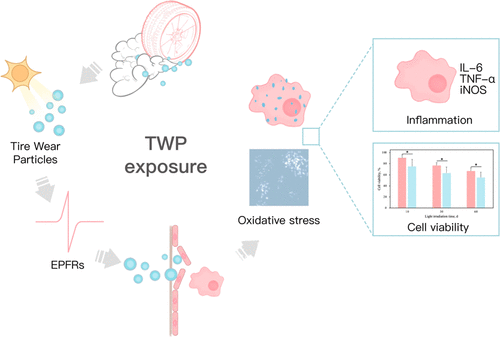当前位置:
X-MOL 学术
›
Environ. Sci. Technol.
›
论文详情
Our official English website, www.x-mol.net, welcomes your
feedback! (Note: you will need to create a separate account there.)
In Vitro Assessment Reveals the Effects of Environmentally Persistent Free Radicals on the Toxicity of Photoaged Tire Wear Particles
Environmental Science & Technology ( IF 10.8 ) Pub Date : 2021-11-25 , DOI: 10.1021/acs.est.1c05092 Ze Liu 1 , Yajiao Sun 1 , Jianqun Wang 2 , Jiahui Li 1 , Hanzhong Jia 1
Environmental Science & Technology ( IF 10.8 ) Pub Date : 2021-11-25 , DOI: 10.1021/acs.est.1c05092 Ze Liu 1 , Yajiao Sun 1 , Jianqun Wang 2 , Jiahui Li 1 , Hanzhong Jia 1
Affiliation

|
Tire wear particles (TWP) have been identified as one of the major sources of microplastics (MPs), and few studies have focused on their environmental behaviors and impacts. However, a thorough characteristic and toxicity assessment associated with environmentally persistent free radicals (EPFRs) on the photoaged TWP is missing. In this study, we investigated EPFRs in the process of TWP photoaging and evaluated their toxicity using in vitro bioassays. Our results showed that a total of around 1.0 × 1017 spins/g EPFRs (g-factors ranging 2.00308–2.00318) was formed on TWP with 60 days of light irradiation, which contained more than 29% of reactive EPFRs (r-EPFRs). Using macrophages as model cells for bioassays, TWP-associated EPFRs trigged endpoints, including the decrease of cell viability (27 to 45%) and the increase of oxidative stress response (46–93%) and inflammatory factor secretion. The enhancement of TWP toxicity with photoaging was confirmed to be attributed to the generated EPFRs combined with other TWP’s chemical compositions (e.g., various metals and organics). Most importantly, the toxicity of photoaged TWP was closely correlated with the generated r-EPFRs, which induced reactive oxidant species (ROS) generation. This study provides direct evidence of toxicity on the photoaged TWP particles, revealing the potential contributions of EPFRs to the adverse effect on human health and highlighting the need for an improved understanding of the impacts of EPFRs on the risk assessment of TWP released into the environment.
中文翻译:

体外评估揭示了环境持久性自由基对光老化轮胎磨损颗粒毒性的影响
轮胎磨损颗粒 (TWP) 已被确定为微塑料 (MPs) 的主要来源之一,很少有研究关注它们的环境行为和影响。然而,缺少与光老化 TWP 上的环境持久性自由基 (EPFR) 相关的全面特性和毒性评估。在这项研究中,我们研究了 TWP 光老化过程中的 EPFR,并使用体外生物测定评估了它们的毒性。我们的结果表明,总共有大约 1.0 × 10 17 spins/g EPFRs ( g2.00308–2.00318) 范围内的因子在 TWP 上形成,光照 60 天,其中含有超过 29% 的反应性 EPFRs (r-EPFRs)。使用巨噬细胞作为生物测定的模型细胞,TWP 相关的 EPFR 触发了终点,包括细胞活力的降低(27% 至 45%)和氧化应激反应的增加(46% 至 93%)和炎症因子的分泌。TWP 毒性随光老化的增强被证实归因于生成的 EPFRs 与其他 TWP 的化学成分(例如,各种金属和有机物)相结合。最重要的是,光老化 TWP 的毒性与产生的 r-EPFRs 密切相关,后者可诱导活性氧化剂 (ROS) 的产生。这项研究提供了光老化 TWP 颗粒毒性的直接证据,
更新日期:2022-02-01
中文翻译:

体外评估揭示了环境持久性自由基对光老化轮胎磨损颗粒毒性的影响
轮胎磨损颗粒 (TWP) 已被确定为微塑料 (MPs) 的主要来源之一,很少有研究关注它们的环境行为和影响。然而,缺少与光老化 TWP 上的环境持久性自由基 (EPFR) 相关的全面特性和毒性评估。在这项研究中,我们研究了 TWP 光老化过程中的 EPFR,并使用体外生物测定评估了它们的毒性。我们的结果表明,总共有大约 1.0 × 10 17 spins/g EPFRs ( g2.00308–2.00318) 范围内的因子在 TWP 上形成,光照 60 天,其中含有超过 29% 的反应性 EPFRs (r-EPFRs)。使用巨噬细胞作为生物测定的模型细胞,TWP 相关的 EPFR 触发了终点,包括细胞活力的降低(27% 至 45%)和氧化应激反应的增加(46% 至 93%)和炎症因子的分泌。TWP 毒性随光老化的增强被证实归因于生成的 EPFRs 与其他 TWP 的化学成分(例如,各种金属和有机物)相结合。最重要的是,光老化 TWP 的毒性与产生的 r-EPFRs 密切相关,后者可诱导活性氧化剂 (ROS) 的产生。这项研究提供了光老化 TWP 颗粒毒性的直接证据,











































 京公网安备 11010802027423号
京公网安备 11010802027423号